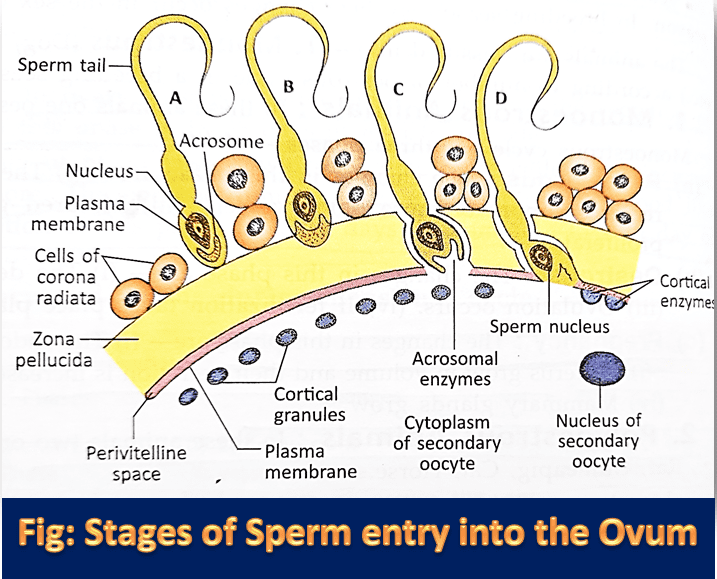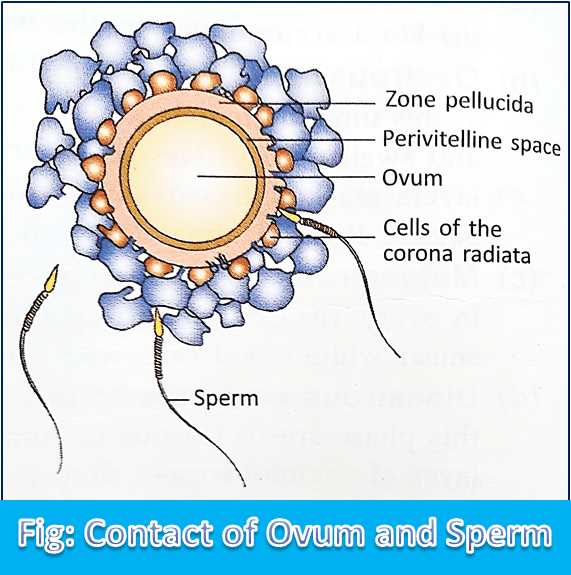Fertilization:
The process of union of sperm (n) and ovum (n) is called fertilization. As a result of fertilization, a zygote (2n) is formed.
Mechanism of Fertilization:
Fertilization occurs by the following sequences –
1. Gametes:
The male gamete is called sperm or spermatozoa. A mature spermatozoon is made of four parts – i. Head, ii. Neck, iii. Body and iv. Tail. The anterior portion of the head of sperm contains an acrosome, which is derived from the Golgi body. After the acrosomal part nucleus is seen. Dense chromatin constructs the nucleus.
2. Arrival of Sperm:
About 200-300 million sperms are discharged with semen in the vagina of the female during copulation. This process is known as insemination.
3. Arrival of Secondary Oocyte:
After release from the mature Graafian follicle of the ovary, the secondary oocyte is received by the nearby fallopian funnel and then sent to the fallopian tube by the movement of fimbriae and their cilia.
4. Capacitation of Sperm:
Just released sperms are not able to fertilize the ovum. After residing over 5-6 hours long time in the female genital tracts sperm bears the capacity to fertilize. Now sperm moves or travels up from the vaginal passage of the female towards the uterus. Most of them are destroyed in the passage. But only a few thousand find their way into the opening of the fallopian tube. Out of them only one called ‘Fit Sperm’ is able to fertilize the ovum. Primarily, contractions of the uterus and fallopian tubes help in sperm movement but later on they move by their own ability.

During a residence in the epididymis plasma membrane of the acrosome gets solidified by the deposition of glycoprotein and cholesterol. During capacitation, this glycoprotein and cholesterol of the plasma membrane are released which causes modification in the membrane and results in the easy secretion of acrosomal enzymes. Thus the receptor sites on the acrosome are exposed and sperm becomes active to penetrate the egg. This phenomenon of sperm activation in mammals is known as capacitation. It takes about 5-6 hours.
5. Contact of ovum and sperm:
Contact of ovum and sperm takes place at the ampullary isthmic junction of the fallopian tube. The secondary oocyte can be fertilized only within 24 hours after its release from the ovary. The life of sperms discharged in the female genital passage is 72 hours but their power of fertilization remains up to 48 hours.

6. Penetration:
The ovum discharged from the Graafian follicle of the ovary has a layer of granular cells with hyaluronic acid all around it. This is called corona radiata. The acrosome of sperm secretes hyaluronidase enzymes which neutralize hyaluronic acid. The sperm then penetrates the corona radiata and touches the zona pellucida of ovum.
7. Formation of Male and Female Pronucleus:
In the ooplasm, the head of the sperm is covered by the male pronucleus. On the other side, the ovum undergoes a second meiotic division. It loses the second polar body and is converted to a female pronucleus.
8. Fusion of Male and Female Pronucleus:
After the second meiotic division of the ovum and the formation of the female pronucleus, the male pronucleus comes nearer to it. At this time, asters are formed from the pronucleus. The centrosome of sperm appears between the two pronuclei. The centriole divides into two which are arranged at opposite poles. Then the male and female pronucleus each with 23 chromosomes unite together. Mixing up of the chromosome of a sperm and ovum is termed Amphimixis or Karyogamy. As a result, the zygote will have 46 chromosomes are formed. With the formation of the zygote, pregnancy begins.